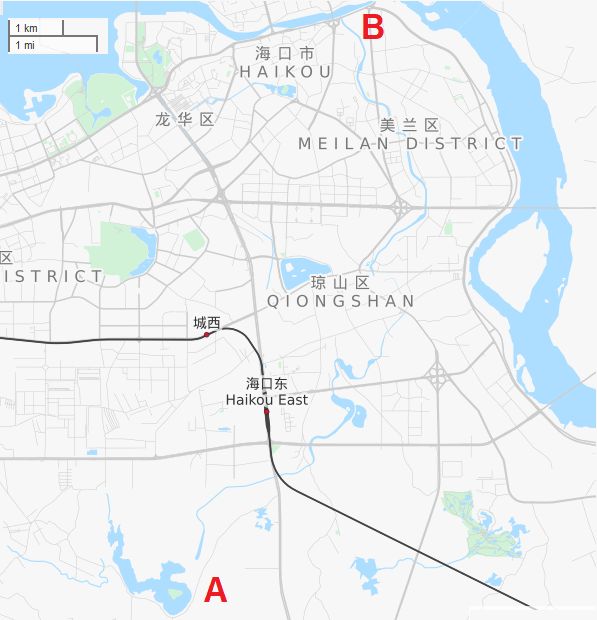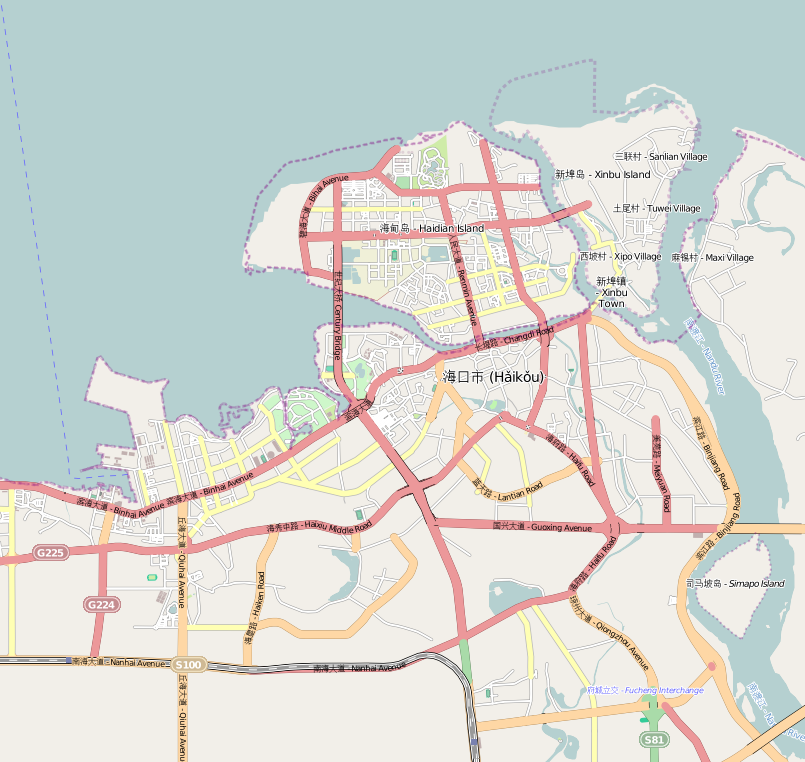|
Meishe River
The Meishe River () is a river within Haikou City, Hainan, China. Its source is the spillway at the east end of the Shapo Reservoir located just south of the city. The Meishe flows eastward under Longkun Road south of the Haikou East Railway Station. It then turns north, past the Meishe River National Wetland Park and winds northward through the east side of urban Haikou, under Guoxing Avenue Guoxing Avenue () is a major street in Haikou, Hainan, China. It runs in an east-west direction in the heart of the city. Its west end terminates at Longkun Road and its east end terminates at the Qiongzhou Bridge which crosses the Nandu River. Hi ..., finally emptying into the Haidian River just east of Heping Bridge. References External links * {{China-river-stub Rivers of Hainan Haikou ... [...More Info...] [...Related Items...] OR: [Wikipedia] [Google] [Baidu] |
Meishe River National Wetland Park
The Meishe River National Wetland Park () is an eco-park on the banks for the Meishe River in Haikou, Hainan, China. It is located on the north side of Yehai Avenue, around 1.5 km east of Haikou East railway station Haikou East railway station is a railway station on the Hainan eastern ring high-speed railway located at the south end of Longqun Road in Haikou Haikou (; ), also spelled as Hoikow is the capital and most populous city of the Chinese pro ... and Longqun Avenue. It was built over a nine-month period around 2017. The park covers 14,000 square meters, and is situated on top of a former waste dump. It is a terraced field with eight stages, the largest of its kind in China. This wetland park can treat 5,000 to 8,000 metric tons of household sewage per day. It is now an urban oasis inhabited by water plants, such as water lilies and irises, and numerous species of waterfowl including egrets. References External links Images {{coord, 19.9802, N, 110.3565, ... [...More Info...] [...Related Items...] OR: [Wikipedia] [Google] [Baidu] |
Shapo Reservoir
The Shapo Reservoir () is located 5 km south of Haikou city, Hainan, China, south of Shapo Village at Chengxi Town. The purpose of this reservoir is to prevent floods and conserve water to supply to Haikou. It is roughly 2 km long. A single dam is located at the northeast bank. Water released from this dam flows into a spillway and then starts the Meishe River. This narrow river then flows eastward under Longkun Road just south of the Haikou East Railway Station. It then turns north, runs past the Meishe River National Wetland Park, and empties into the Haidian River. Design and construction The Shapo Reservoir was designed and is administered within Longhua District, Haikou, Longhua District's jurisdiction. Construction of the reservoir started in 1959 and was completed in 1964. Reinforcements were made in 2013. Description The reservoir Shapo is a medium-size reservoir being 27.46 km2. It can hold 14,190,000 cubic metres of water. The normal water level is 30 metres, ... [...More Info...] [...Related Items...] OR: [Wikipedia] [Google] [Baidu] |
Haikou
Haikou (; ), also spelled as Hoikow is the capital and most populous city of the Chinese province of Hainan. Haikou city is situated on the northern coast of Hainan, by the mouth of the Nandu River. The northern part of the city is on the Haidian Island, which is separated from the main part of Haikou by the Haidian River, a branch of the Nandu. Administratively, Haikou is a prefecture-level city, comprising four districts, and covering . There are 2,046,189 inhabitants in the built-up area, all living within the four urban districts of the city. Haikou was originally a port city, serving as the port for Qiongshan. During the Chinese Civil War, Haikou was one of the last Nationalist strongholds to be taken by the Communists — with the Battle of Hainan Island in 1950. Currently, more than half of the island's total trade still goes through Haikou's ports. The Temple of the Five Lords is located to the southeast of the city. The city is home to Hainan University, a comprehen ... [...More Info...] [...Related Items...] OR: [Wikipedia] [Google] [Baidu] |
Haidian River
The Haidian River () runs through Haikou City, separating the main part of and its northern part Haidian Island, in Hainan province. Its tributary is the Nandu River. There are three bridges that cross the river: *Haikou Century Bridge near the mouth of the Haidian River at Haikou Bay. *Renmin Bridge () crosses a narrow section of the Haidian River linking Changdi Road () with Renmin Avenue (). *Heping Bridge () connects Changdi Road and Heping Avenue () across the Haidian River. Haikou New Port is located on the south bank of this river. Gallery Image:Haikou Century Bridge Haikou 7.jpg, Haikou Century Bridge crossing the Haidian River at its mouth at Haikou Bay Image:Haidian River 01.jpg, A view from the south side, about midpoint of the length of the river, facing east, with Haidian Island on the opposite bank, with Heping Bridge visible in background. Image:Haidian River at mouth entering Haikou Bay 01.jpg, Mouth of the Haidian River entering Haikou Bay, with Haikou Century ... [...More Info...] [...Related Items...] OR: [Wikipedia] [Google] [Baidu] |
Haikou East Railway Station
Haikou East railway station is a railway station on the Hainan eastern ring high-speed railway located at the south end of Longqun Road in Haikou, Hainan, China. In 2018, the Haikou Transportation Center Haikou Transportation Center (), also known as Haikou Bus terminal, is the main bus station serving Haikou, Hainan, China. It is located across the road from Haikou East railway station's south side. It was built during 2017 and opened in October ..., the main bus station, relocated and is now directly to the south east of Haikou East Railway Station. Gallery Image:Haikou East Railway Station interior 05.jpg, Main hall External links * Railway stations in Hainan Buildings and structures in Haikou {{Hainan-railstation-stub ... [...More Info...] [...Related Items...] OR: [Wikipedia] [Google] [Baidu] |
Guoxing Avenue
Guoxing Avenue () is a major street in Haikou, Hainan, China. It runs in an east-west direction in the heart of the city. Its west end terminates at Longkun Road and its east end terminates at the Qiongzhou Bridge which crosses the Nandu River. History Guoxing Avenue was once Haikou's main airport (since relocated to Haikou Meilan International Airport southeast of the city centre). Built around 2005, the avenue was first seldom used for vehicular traffic route. Most of the land on the north and south sides were unoccupied. It has since become a heavily trafficked road. In 2017, the west end was connected to a newly built road that provides access to the new neighbourhood 'Haikou West Coast' located around 7 km west of the Haikou city centre. The east end of Guoxing connects to the route to Haikou Meilan International Airport. Notable locations Guoxing can be considered as having two parts separated by the north-south Haifu Road: West The west part contains the following: ... [...More Info...] [...Related Items...] OR: [Wikipedia] [Google] [Baidu] |
Rivers Of Hainan
A river is a natural flowing watercourse, usually freshwater, flowing towards an ocean, sea, lake or another river. In some cases, a river flows into the ground and becomes dry at the end of its course without reaching another body of water. Small rivers can be referred to using names such as creek, brook, rivulet, and rill. There are no official definitions for the generic term river as applied to geographic features, although in some countries or communities a stream is defined by its size. Many names for small rivers are specific to geographic location; examples are "run" in some parts of the United States, "burn" in Scotland and northeast England, and "beck" in northern England. Sometimes a river is defined as being larger than a creek, but not always: the language is vague. Rivers are part of the water cycle. Water generally collects in a river from precipitation through a drainage basin from surface runoff and other sources such as groundwater recharge, springs ... [...More Info...] [...Related Items...] OR: [Wikipedia] [Google] [Baidu] |





